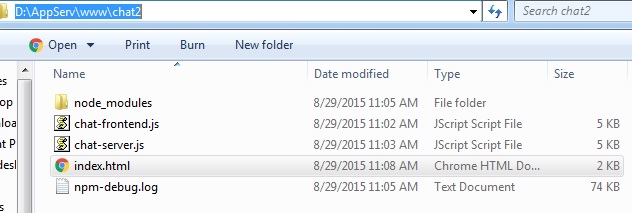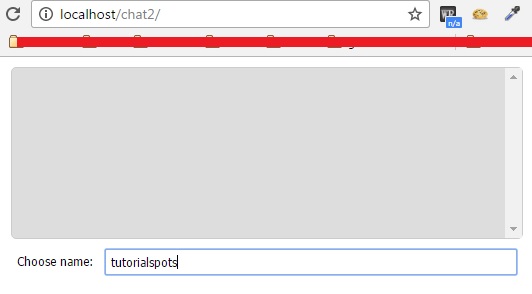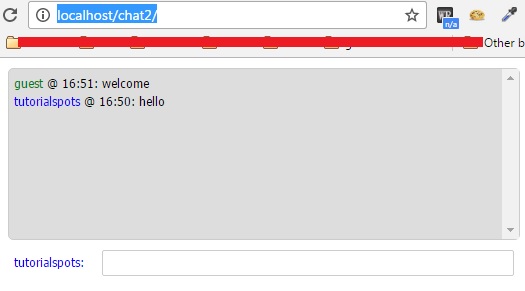Previous tutorial: Example chat application using Nodejs + Socket.io
With Nodejs, we can create real-time application like chat-room. We can use Socket.io, WS or Websocket. Today, we introduce a simple chat application with Nodejs + Websocket
Application structure:
File index.html
<!DOCTYPE html>
<html>
<head>
<meta charset="utf-8">
<title>WebSockets - Simple chat</title>
<style>
* { font-family:tahoma; font-size:12px; padding:0px; margin:0px; }
p { line-height:18px; }
div { width:500px; margin-left:auto; margin-right:auto;}
#content { padding:5px; background:#ddd; border-radius:5px; overflow-y: scroll;
border:1px solid #CCC; margin-top:10px; height: 160px; }
#input { border-radius:2px; border:1px solid #ccc;
margin-top:10px; padding:5px; width:400px; }
#status { width:88px; display:block; float:left; margin-top:15px; }
</style>
</head>
<body>
<div id="content"></div>
<div>
<span id="status">Connecting...</span>
<input type="text" id="input" disabled="disabled" />
</div>
<script src="//ajax.googleapis.com/ajax/libs/jquery/1.9.1/jquery.min.js"></script>
<script src="./chat-frontend.js"></script>
</body>
</html>
File chat-frontend.js
$(function () {
"use strict";
// for better performance - to avoid searching in DOM
var content = $('#content');
var input = $('#input');
var status = $('#status');
// my color assigned by the server
var myColor = false;
// my name sent to the server
var myName = false;
// if user is running mozilla then use it's built-in WebSocket
window.WebSocket = window.WebSocket || window.MozWebSocket;
// if browser doesn't support WebSocket, just show some notification and exit
if (!window.WebSocket) {
content.html($('<p>', { text: 'Sorry, but your browser doesn\'t '
+ 'support WebSockets.'} ));
input.hide();
$('span').hide();
return;
}
// open connection
var connection = new WebSocket('ws://127.0.0.1:1337');
connection.onopen = function () {
// first we want users to enter their names
input.removeAttr('disabled');
status.text('Choose name:');
};
connection.onerror = function (error) {
// just in there were some problems with conenction...
content.html($('<p>', { text: 'Sorry, but there\'s some problem with your '
+ 'connection or the server is down.' } ));
};
// most important part - incoming messages
connection.onmessage = function (message) {
// try to parse JSON message. Because we know that the server always returns
// JSON this should work without any problem but we should make sure that
// the massage is not chunked or otherwise damaged.
try {
var json = JSON.parse(message.data);
} catch (e) {
console.log('This doesn\'t look like a valid JSON: ', message.data);
return;
}
// NOTE: if you're not sure about the JSON structure
// check the server source code above
if (json.type === 'color') { // first response from the server with user's color
myColor = json.data;
status.text(myName + ': ').css('color', myColor);
input.removeAttr('disabled').focus();
// from now user can start sending messages
} else if (json.type === 'history') { // entire message history
// insert every single message to the chat window
for (var i=0; i < json.data.length; i++) {
addMessage(json.data[i].author, json.data[i].text,
json.data[i].color, new Date(json.data[i].time));
}
} else if (json.type === 'message') { // it's a single message
input.removeAttr('disabled'); // let the user write another message
addMessage(json.data.author, json.data.text,
json.data.color, new Date(json.data.time));
} else {
console.log('Hmm..., I\'ve never seen JSON like this: ', json);
}
};
/**
* Send mesage when user presses Enter key
*/
input.keydown(function(e) {
if (e.keyCode === 13) {
var msg = $(this).val();
if (!msg) {
return;
}
// send the message as an ordinary text
connection.send(msg);
$(this).val('');
// disable the input field to make the user wait until server
// sends back response
input.attr('disabled', 'disabled');
// we know that the first message sent from a user their name
if (myName === false) {
myName = msg;
}
}
});
/**
* This method is optional. If the server wasn't able to respond to the
* in 3 seconds then show some error message to notify the user that
* something is wrong.
*/
setInterval(function() {
if (connection.readyState !== 1) {
status.text('Error');
input.attr('disabled', 'disabled').val('Unable to comminucate '
+ 'with the WebSocket server.');
}
}, 3000);
/**
* Add message to the chat window
*/
function addMessage(author, message, color, dt) {
content.prepend('<p><span style="color:' + color + '">' + author + '</span> @ ' +
+ (dt.getHours() < 10 ? '0' + dt.getHours() : dt.getHours()) + ':'
+ (dt.getMinutes() < 10 ? '0' + dt.getMinutes() : dt.getMinutes())
+ ': ' + message + '</p>');
}
});
File: chat-server.js
// http://ejohn.org/blog/ecmascript-5-strict-mode-json-and-more/
"use strict";
// Optional. You will see this name in eg. 'ps' or 'top' command
process.title = 'node-chat';
// Port where we'll run the websocket server
var webSocketsServerPort = 1337;
// websocket and http servers
var webSocketServer = require('websocket').server;
var http = require('http');
/**
* Global variables
*/
// latest 100 messages
var history = [ ];
// list of currently connected clients (users)
var clients = [ ];
/**
* Helper function for escaping input strings
*/
function htmlEntities(str) {
return String(str).replace(/&/g, '&').replace(/</g, '<')
.replace(/>/g, '>').replace(/"/g, '"');
}
// Array with some colors
var colors = [ 'red', 'green', 'blue', 'magenta', 'purple', 'plum', 'orange' ];
// ... in random order
colors.sort(function(a,b) { return Math.random() > 0.5; } );
/**
* HTTP server
*/
var server = http.createServer(function(request, response) {
// Not important for us. We're writing WebSocket server, not HTTP server
});
server.listen(webSocketsServerPort, function() {
console.log((new Date()) + " Server is listening on port " + webSocketsServerPort);
});
/**
* WebSocket server
*/
var wsServer = new webSocketServer({
// WebSocket server is tied to a HTTP server. WebSocket request is just
// an enhanced HTTP request. For more info http://tools.ietf.org/html/rfc6455#page-6
httpServer: server
});
// This callback function is called every time someone
// tries to connect to the WebSocket server
wsServer.on('request', function(request) {
console.log((new Date()) + ' Connection from origin ' + request.origin + '.');
// accept connection - you should check 'request.origin' to make sure that
// client is connecting from your website
// (http://en.wikipedia.org/wiki/Same_origin_policy)
var connection = request.accept(null, request.origin);
// we need to know client index to remove them on 'close' event
var index = clients.push(connection) - 1;
var userName = false;
var userColor = false;
console.log((new Date()) + ' Connection accepted.');
// send back chat history
if (history.length > 0) {
connection.sendUTF(JSON.stringify( { type: 'history', data: history} ));
}
// user sent some message
connection.on('message', function(message) {
if (message.type === 'utf8') { // accept only text
if (userName === false) { // first message sent by user is their name
// remember user name
userName = htmlEntities(message.utf8Data);
// get random color and send it back to the user
userColor = colors.shift();
connection.sendUTF(JSON.stringify({ type:'color', data: userColor }));
console.log((new Date()) + ' User is known as: ' + userName
+ ' with ' + userColor + ' color.');
} else { // log and broadcast the message
console.log((new Date()) + ' Received Message from '
+ userName + ': ' + message.utf8Data);
// we want to keep history of all sent messages
var obj = {
time: (new Date()).getTime(),
text: htmlEntities(message.utf8Data),
author: userName,
color: userColor
};
history.push(obj);
history = history.slice(-100);
// broadcast message to all connected clients
var json = JSON.stringify({ type:'message', data: obj });
for (var i=0; i < clients.length; i++) {
clients[i].sendUTF(json);
}
}
}
});
// user disconnected
connection.on('close', function(connection) {
if (userName !== false && userColor !== false) {
console.log((new Date()) + " Peer "
+ connection.remoteAddress + " disconnected.");
// remove user from the list of connected clients
clients.splice(index, 1);
// push back user's color to be reused by another user
colors.push(userColor);
}
});
});
Run: npm install websocket to install Websocket
Run: node chat-server.js
Go to website: http://localhost/chat2/
Next tutorial: Example chat application using Nodejs + ws







1 Comment
Example chat application using Nodejs + ws | Free Online Tutorials
(January 18, 2018 - 3:59 pm)[…] Previous tutorial: Example chat application using Nodejs + Websocket […]